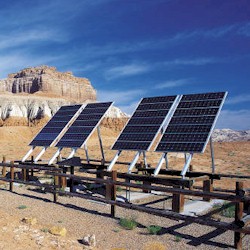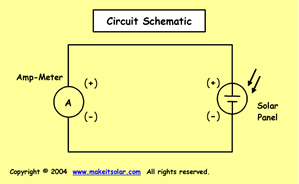Angle of Sun on a Panel
The position of the Sun changes during the day. There is also a change of the Sun's position, or angle in the sky, from summer to winter. The Sun is higher in the sky in the summer. As the position of the Sun changes the angle of sunlight that falls onto a solar panel changes.

Solar panels get the most sunlight energy when they are facing directly at the Sun. To optimize the amount of energy received some are designed to move or track with the Sun during the day. Since tracking systems are an additional cost some panel positions are only changed in winter and summer or not at all.
If you are under 18 years old, get permission from an adult to do this experiment.
Science Fair Project Idea/ Objective:
To demonstrate how the power from a solar panel changes as the angle of light that hits it changes. You will develop this project idea by measuring the change in amperage of the solar panel as the time of day changes.
Hypothesis:
A solar panel will deliver the most power when it is facing directly at the sun.
Materials:
- Solar Panel
- Multi-meter to measure Milli-Amps.
- Graph paper and pencil
Schematic: (large image)

Set Up:
- Find a single sunny spot outside that gets sun for most of the day. You will do your experiments once every hour from 9:00 AM to 3:00 PM.
- Connect the ammeter to the solar panel and set the solar panel on a flat surface. Set the ammeter output so that it will read milli-amps (mA).
Procedure
- Print out this work sheet or make your own.
- Set up your equipment. Lay the solar panel on a flat surface so that it is facing straight up and keep it in the same position for all of your experiments.
- Begin your testing at 9:00. Record the time of day and the mA reading on your ammeter.
- Leave the solar panel in place. Come back in 1 hour to collect more data. Record the time of day and the mA reading on your ammeter.
- Repeat step #4 at 10:00, 11:00, 12:00, 1:00, 2:00, 3:00 and 4:00. Each time, record the time of day and mA reading on your ammeter.
- Graph your data for mAmps (Y-axis) as a function of the time of day (X-axis).
Expected Results:
Your readings should be the highest when the Sun is at its highest point in the sky because this is when your solar panel is exposed to the most direct sunlight. At what time did you get your greatest reading?
Try This:
Try this same experiment during both winter and summer. During which season do you think you will get the highest readings? Why?